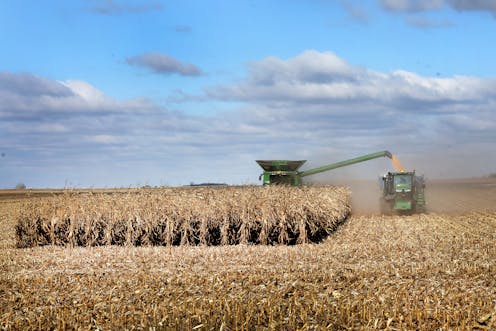
A farmer harvests corn near McIntire, Iowa, on Oct. 31, 2023. Scott Olson/Getty Images
Two years after President Abraham Lincoln created the Department of Agriculture in 1862, he nicknamed it “the people’s department” because half of all Americans lived on farms at that time. Today, fewer than 2% of Americans farm, but the Agriculture Department still touches people’s lives in many ways.
The modern U.S. Department of Agriculture is a sprawling bureaucracy with a US$231 billion annual budget. Although it is headquartered in Washington, D.C., about 90% of its employees work in field offices nationwide. Others serve in nearly 100 embassies around the world as part of the Foreign Agriculture Service, promoting U.S. food and farm products.
The most common misconception about the USDA is that it’s mainly focused on supporting farmers and ranchers and conserving agricultural land. These are critical missions, but as a former deputy secretary of agriculture, I can attest that they represent only a small slice of what the department does.
For example, nutrition assistance programs help tens of millions of people escape food insecurity annually. They consume 70% to 80% of the USDA’s total annual budget, depending on the year, and include school meals, nutritional support for women, infants and children, and food benefits for low-income families. In contrast, only 13% of the agency’s budget goes to farm, conservation and commodity programs.
The USDA’s food and nutrition programs serve 1 in 4 Americans by helping them afford adequate supplies of healthy food.
If confirmed, Brooke Rollins, President Donald Trump’s choice for agriculture secretary, will manage one of the largest federal bureaucracies and work with Congress in the writing of reconciliation and farm bills. In addition, she likely will be drawn into debates about reducing food prices and consumption of processed and sugary foods.
A lifeline for rural America
Throughout the Department of Agriculture’s history, presidents have used it as a tool to address rural America’s needs, extending well beyond farms. This role continues today, even as the U.S. has become a much more urban nation.
Need broadband, water or wastewater systems? Need to build a library, community center or hospital? For small towns, the USDA will help fund all these things, along with the purchase of fire trucks and police cars. If you live in a community with a population under 35,000, the agency may help you buy, build or repair affordable homes.
One of my favorite programs is the Business and Industry Loan Guarantee Program, which helps private businesses refinance debt, purchase land and machinery, and build factories, among other things. It does this by guaranteeing loans to reduce risk for commercial lenders, which helps borrowers get financing at the best rate.
From grading eggs to fighting wildfires
The Department of Agriculture has 17 agencies whose focuses range from food safety to research, nutrition, conservation, rural development and more. I served from 1999 to 2001 as administrator of the Agricultural Marketing Service, which oversees food standards that define categories such as Grade A eggs, prime beef and organic products.
The U.S. Forest Service is the largest USDA agency, with 33,000 employees. It manages 106 national forests across 37 states, assists in urban tree management and conducts research on trees, wood products and wildlife. Originally, the agency’s mission centered on producing timber, but now it also manages forests for other benefits, such as wildlife habitat and recreation.
About 10,000 Forest Service employees are firefighters. This once was a seasonal job, but climate change is making it a year-round occupation. Each year the agency battles about 5,000 to 7,000 fires on national forest lands and helps fight fires elsewhere.
Seneca Rocks in West Virginia’s Monongahela National Forest. The Agriculture Department manages national forests for purposes including timber production, recreation, wildlife habitat and drinking water.
Preston Keres, USFS/Flickr
Farm bill in limbo, SNAP in the crosshairs
About every five years, Congress debates a farm bill – a massive piece of legislation that sets directions for about $662 billion in spending over five years and determines about 70% of what the Department of Agriculture does. The last farm bill was enacted in 2018, so a new measure is overdue.
In December 2024, Congress passed the American Relief Act, which included $10 billion in farm market relief, $21 billion in disaster assistance for farmers and a yearlong extension of the current farm bill law. The next big agricultural question that Congress will address is a brewing battle over funding for the Supplemental Nutrition Assistant Program, or SNAP, which helps about 42 million low-income people supplement their grocery budgets.
SNAP is a likely target in the budget reconciliation process that Congress is expected to consider early in 2025. Republican leaders are aiming to cut SNAP funding to achieve multiyear budget savings that can be repurposed for farm interests.
Because budget reconciliation requires only a majority of votes in the Senate, it is filibuster-proof, unlike a farm bill. This means that cutting SNAP, which typically spurs sharp debate between critics who say the program is too costly and advocates who call it a key part of the social safety net, will be easier to accomplish.
Special financing authority
Another potentially controversial agriculture issue is the agency’s ability to borrow up to $30 billion directly from the U.S. Treasury at any one time, with appropriations from Congress repaying the loan if the agency falls short. This is done through the Commodity Credit Corporation, a government-owned financing authority established by Congress in 1933 to help stabilize farm prices.
I served as vice chair of the corporation, a position that required its own Senate confirmation. Other federal departments envy its power, which traditionally has been used to make payments and loans that help stabilize farm income.
Recently, however, administrations have used it for broader purposes. Those include compensating farmers hurt by tariff wars during the first Trump term and addressing climate change and other priorities during the Biden administration.
Expanded use of the Commodity Credit Corporation has irritated members of Congress, who derisively refer to it as the Department of Agriculture’s slush fund. This little-known and little-understood mechanism could become a central issue in the forthcoming farm bill.
New challenges for the incoming secretary
Project 2025, a transition plan produced by the conservative Heritage Foundation and embraced by many Trump supporters, calls on Congress to reduce the scope of the USDA’s activities and refocus the department’s mission narrowly on food production. This would mean cutting programs in other areas, such as conservation on farmlands, or moving them to other agencies, as the plan recommends for nutrition programs such as SNAP.
But with so many constituents for the USDA’s services, including all those rural towns that receive funding from the department now, I believe it will be difficult for the new secretary to concede to conservative demands for policies that stop at the farm’s edge.
The USDA also faces broader challenges. They include the ongoing outbreak of avian flu, which has forced farmers to destroy millions of chickens and turkeys since early 2022 and now is spreading in dairy cattle, threatening dairy workers and the safety of the national milk supply.
A broader issue is the cost of food, which galvanized voters in the 2024 elections after inflation during the Biden administration led to historic increases in food prices. Trump has acknowledged the importance of this issue, saying, “I won on the border, and I won on groceries.”
President Trump campaigned on reducing consumer food bills, but many economists are skeptical that any administration can significantly affect food prices.
Many experts believe there is little the USDA can do to directly lower food prices. Nevertheless, the next secretary will need to manage public and White House expectations. If Trump’s mass deportation plans affect many farm workers, that could put upward pressure on food prices.
Finally, Robert F. Kennedy Jr., Trump’s choice to lead the Department of Health and Human Services, has a lot to say about what the USDA should do. Kennedy has called widely for making America healthy again, an idea that Trump appears to embrace.
Among other things, Kennedy sharply criticizes “Big Food,” referring to large-scale corporate food and agriculture enterprises that produce much of the U.S. food supply. He supports restricting SNAP purchases to healthy foods, eliminating ultra-processed foods and banning toxic pesticides. If Kennedy is confirmed, he may have Trump’s ear on key issues before the USDA.
This story is part of a series of profiles of Cabinet and high-level administration positions.
Kathleen Merrigan has received several grants from USDA. Previously she was employed by the agency as Deputy Secretary (2009-2013) and Agricultural Marketing Service Administrator (1999-2001)
Advertisement

Advertisement
Contact Us
If you would like to place dofollow backlinks in our website or paid content reach out to info@qhubonews.com









